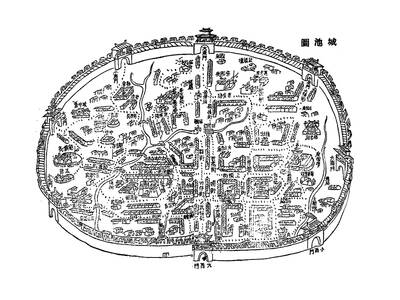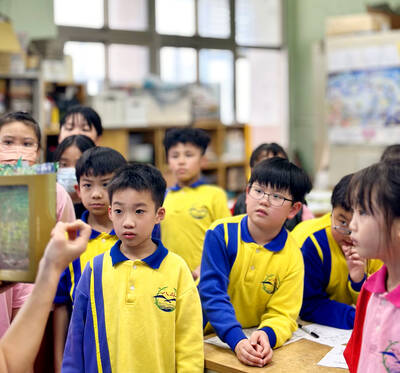Anna Possi answers the phone in the cafe but immediately asks to call her back. “I have a customer,” she says.
It’s mid-afternoon and Possi, who owns Bar Centrale in Nebbiuno, a small town overlooking Lake Maggiore in northern Italy, has been serving coffee since 7am. She usually finishes at 7pm.
It’s an average working day for a barista in Italy, but Possi is in one key respect far from the average barista: aged 100, she is the country’s oldest. The centenarian, who recently had bestowed upon her the honorary title of Commander of the Republic, is a familiar face to regulars who have lived their lives alongside the cafe as it has matured from cutting edge to vintage. “I’m always working — Sundays, Easter, Christmas. I’m never on holiday,” she says.

Photo: AFP
This has been Possi’s routine since May 1 1958 when she opened the bar with her husband, serving espressos and cappuccinos to customers. Alcoholic beverages were added to the menu in 1971 when the couple purchased a license.
But it was the jukebox that pulled in the punters. Bar Centrale was the place to be.
“They came here to mingle, to dance,” said Possi. “With a foosball table too, we were the most modern bar in town.”
After her husband died in 1974, she dedicated her life to raising their two children and the bar.
“Since dad died she never wanted to have another relationship,” her daughter, Cristina, said. “She focused on us and work.”
Possi described the 1960s through to the 1980s as “the most beautiful years” in the bar’s history. Notable customers along the way included the AC Milan footballers Gianni Rivera and Fulvio Collovati.
However, she is not one for wallowing in nostalgia. The jukebox might be gone but the bar has a bookstand, where customers can swap books and read over their coffee. If they call by on a Sunday, they can get a slice of homemade apple pie.
“With me still serving, today we are known as the vintage bar,” Possi said.
That said, she has a computer on the premises, too, which she uses each morning to peruse the news and consult the stock exchange.
“I read everything. I still want to learn and better understand things,” she says.
Her regular trade consists mostly of the town’s pensioners, who sometimes call in to chat to Possi without actually purchasing anything. But the publicity surrounding her 100th birthday, celebrated on Nov. 16, has generated a flurry of new customers from beyond.
“People come to meet me, because they find it impossible to believe that I’m still working,” she said. “When they leave, they leave happy and recharged — I don’t know what it is that I’ve transmitted.”
In fact, being in the company of others is what Possi believes is the key to her longevity.
“I don’t want to be melancholic,” she said. “I want to live, to be among people.”
She has no intention of stopping work anytime soon.
“I’ll keep going so long as my health permits,” she said, while advising young people to “choose a job you enjoy.”
Possi is among Italy’s growing number of centenarians. According to figures from Istat, the national statistics agency, there were 22,552 people aged over 100 by the end of last year — the highest number recorded. The vast majority of Italian centenarians are women.
Italy’s oldest living person is Claudia Baccarini, 114, and just a month younger is Lucia Laura Sangenito. Emma Morano held the title of the world’s oldest person for 11 months until her death in 2017 at the age of 117.

May 26 to June 1 When the Qing Dynasty first took control over many parts of Taiwan in 1684, it roughly continued the Kingdom of Tungning’s administrative borders (see below), setting up one prefecture and three counties. The actual area of control covered today’s Chiayi, Tainan and Kaohsiung. The administrative center was in Taiwan Prefecture, in today’s Tainan. But as Han settlement expanded and due to rebellions and other international incidents, the administrative units became more complex. By the time Taiwan became a province of the Qing in 1887, there were three prefectures, eleven counties, three subprefectures and one directly-administered prefecture, with

It’s an enormous dome of colorful glass, something between the Sistine Chapel and a Marc Chagall fresco. And yet, it’s just a subway station. Formosa Boulevard is the heart of Kaohsiung’s mass transit system. In metro terms, it’s modest: the only transfer station in a network with just two lines. But it’s a landmark nonetheless: a civic space that serves as much more than a point of transit. On a hot Sunday, the corridors and vast halls are filled with a market selling everything from second-hand clothes to toys and house decorations. It’s just one of the many events the station hosts,

Two moves show Taichung Mayor Lu Shiow-yen (盧秀燕) is gunning for Chinese Nationalist Party (KMT) party chair and the 2028 presidential election. Technically, these are not yet “officially” official, but by the rules of Taiwan politics, she is now on the dance floor. Earlier this month Lu confirmed in an interview in Japan’s Nikkei that she was considering running for KMT chair. This is not new news, but according to reports from her camp she previously was still considering the case for and against running. By choosing a respected, international news outlet, she declared it to the world. While the outside world

Through art and storytelling, La Benida Hui empowers children to become environmental heroes, using everything from SpongeBob to microorganisms to reimagine their relationship with nature. “I tell the students that they have superpowers. It needs to be emphasized that their choices can make a difference,” says Hui, an environmental artist and education specialist. For her second year as Badou Elementary’s artist in residence, Hui leads creative lessons on environmental protection, where students reflect on their relationship with nature and transform beach waste into artworks. Standing in lush green hills overlooking the ocean with land extending into the intertidal zone, the school in Keelung